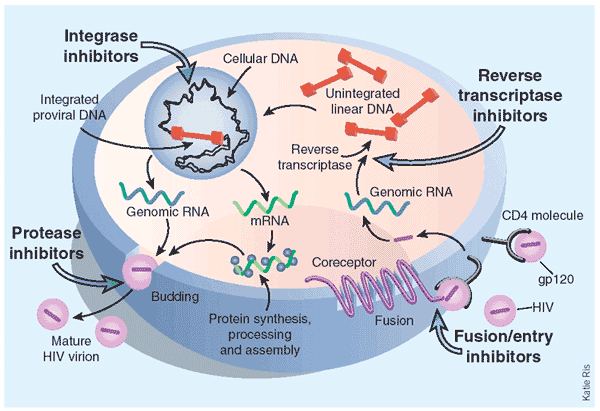
TBC
ANTIRETROVIRAL THERAPY

The FDA has approved more than 25 antiretroviral drugs to treat HIV infection. They can help in these ways:Lower your viral load, fight infection, improve your quality of life, but even when these HIV medications are effective, however, you can still transmit HIV to others. They are not a cure for HIV. The current goals are to: Control the growth of the virusImprove overall immune system function and status, suppress symptoms and produce as few side effects as possible. To do this, doctors recommend that you take a combination of HIV drugs from at least two of the main classes. This combination is called highly active antiretroviral therapy (HAART). It helps combat new resistant strains of the virus that
emerge as HIV makes copies of itself. HAART also decreases the rate of opportunistic infections. (4.1)

When HIV infects a CD4 cell in a person's body, it copies its own genetic code into the cell's DNA. NRTIs, sometimes called "nucleoside analogues" or "nukes," contain faulty versions of the building blocks (nucleotides) used by reverse transcriptase to convert RNA to DNA. When reverse transcriptase uses these faulty building blocks, the new DNA cannot be built correctly. In turn, HIV's genetic material cannot be incorporated into the healthy genetic material of the cell and prevents the cell from producing new virus. (4.2)
Nucleoside/Nucleotide Reverse Transcriptase Inhibitors (NRTIs)

In order for HIV to successfully take over a CD4 cell's machinery so that it can produce new viruses, HIV's RNA is converted into DNA by the reverse transcriptase enzyme. After the "reverse transcription" of RNA into DNA is complete, HIV's DNA must then be incorporated into the CD4 cell's DNA. This is known as integration. Integrase inhibitors work by blocking this process. (4.3)
Integrase Inhibitor

When HIV infects a CD4 cell in a person's body, it copies its own genetic code into the cell's DNA. In this way, the cell is then "programmed" to create new copies of HIV. HIV's genetic material is in the form of RNA. In order for it to infect CD4 cells, it must first convert its RNA into DNA. HIV's reverse transcriptase enzyme is needed to perform this process.NNRTIs, also known as "non-nucleosides" or "non-nukes" for short, attach themselves to reverse transcriptase and prevent the enzyme from converting RNA to DNA. In turn, HIV's genetic material cannot be incorporated into the healthy genetic material of the cell, and prevents the cell from producing new virus. (4.4)
Non-Nucleoside Reverse Transcriptase Inhibitors (NNRTIs)

When HIV infects a CD4 cell in a person's body, it copies its own genetic code into the cell's DNA. The CD4 cell is then "programmed" to make new HIV genetic material and HIV proteins. The proteins must be cut up by the HIV protease—a protein-cutting enzyme—to make functional new HIV particles. PI's block the protease enzyme and prevent the cell from producing new viruses.
(4.5)
Protease Inhibitors
Photo Citation (4.7), (4.8), (4.9), (4.10), (4.11), (4.12)

Entry inhibitors work by attaching themselves to proteins on the surface of CD4 cells or proteins on the surface of HIV. In order for HIV to bind to CD4 cells, the proteins on HIV's outer coat must bind to the proteins on the surface of CD4 cells. Entry inhibitors prevent this from happening. Some entry inhibitors target the gp120 or gp41 proteins on HIV's surface. Some entry inhibitors target the CD4 protein or the CCR5 or CXCR4 receptors on a CD4 cell's surface. If entry inhibitors are successful in blocking these proteins, HIV is unable to bind to the surface of CD4 cells and gain entry into the cells. (4.6)
Entry Inhibitors
Site Designed by LC Shorter / Ms. Keller / Christian Brothers Highschool